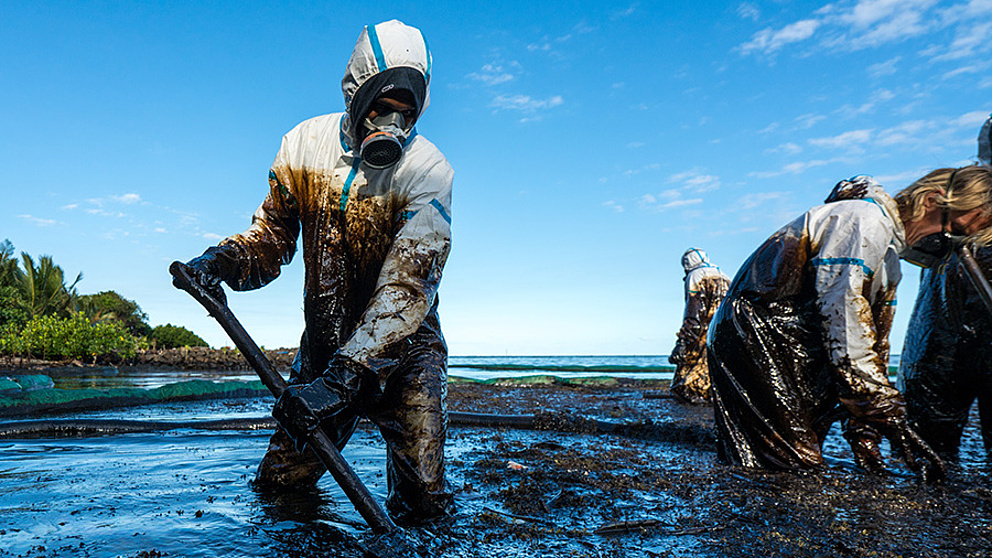

Contact
Press, Communications and Marketing
Tel.: +49 228 833-144
Fax: +49 228 833-441
presse[at]avh.de
Humboldt Foundation: There are plans to take the front part of the wreck of the Wakashio and sink it 13 miles off the eastern coast of Mauritius. What is the situation right now?
Nowsheen Goonoo: This decision has received a lot of criticism as the chosen location for sinking the ship is a primary nursing ground for whales and their calves. Moreover, the impact of the rusting metal of the “Wakashio” on the nursing grounds of these whale populations or on the fragile marine ecosystems along the south east coasts or on Reunion island is still not clear. The presence of heavy metal contaminants in tuna and other deep marine ocean species could have serious implications for the important fishing industry of Mauritius.

What does this disaster mean for the environment?
Considering the biological uniqueness of the region, the main concern is the location of the oil spill rather than its size. Pointe d'Esny, a known sanctuary for rare wildlife such as endemic butterflies, consists of 22 hectares of mangrove wetlands. The mangroves act as habitats and nurseries for several marine species. Not far from Pointe D’Esny is the Blue Bay Marine Park where small quantities of heavy oil have been detected. The 353 hectares covering Marine Park boasts of a coral diversity of 38 coral species across 28 genera and 15 families and is home to more than 233 fish species, 201 shell-bearing mollusk species. The Blue Bay Marine Park is also the nursing ground for the endangered green turtle which lays its eggs in the soft sand of the beach.

What are the worst fears?
Due to the toxic nature of oil, immediate impacts will include deaths of marine species ranging from planktons, fish, birds to dolphins. Marine birds which swim and dive are likely to be covered with the highly viscous oil, making it impossible for them to fly and destroying the birds’ natural insulation and making them vulnerable to hypothermia or overheating. Often, birds end up swallowing the oil in an attempt to free their feathers and this leads to severe internal organ damage and eventually death. Oil will also be disastrous to marine mammals such as dolphins and whales as their blowholes become clogged, leading to difficult breathing and poor communication. Nesting grounds for sea turtles have been contaminated. Sea turtles which come ashore to nest are likely to be affected. Their eggs may be damaged by oil and embryo development may be impaired.
The oil spill location is also close to Ile aux Aigrettes which is nature reserve containing some of the rarest species in the country, such as Mauritius' last remaining low lying ebony forests, pink pigeons, olive white-eye pairs, Telfair skinks, Aldabra tortoises and Mauritian fodies. The Mauritius Wildlife Foundation (MWF) took quick actions to protect the Endangered and Critically Endangered flora and fauna of Ile aux Aigrettes by transferring animals and plants to the mainland until an improvement in conditions is noted.
You are an expert for biopolymers which you want to use for medical applications, such as the production of wound dressing materials. You work with brown seaweeds mainly. How will this disaster impact your research work?
The oil spill certainly impacted on seaweeds which are the source of the polymers used for my research study. Seaweeds became coated with the thick viscous oil and many of them died and were washed ashore. Heavy metals present in the oil slick are likely to accumulate within the seaweeds over time and this need to be carefully monitored. Only when levels are within acceptable range, will we be able to use seaweeds from the South East region for biomedical applications.
How do Mauritians see the future to come?
Mauritians are sad and angry with the way the situation was handled and many believe that the oil spill could have been prevented if actions by the government were taken earlier.
We have already received equipment, and technical assistance from India and France. Japan is also helping out by sending a group of experts who will work closely with the National Crisis Management Committee.There was an overwhelming solidarity amongst local residents who have been scooping oil from the shores using buckets, and shovels. Grocery chains, house moving companies even lent their vehicles to help volunteers transport necessary items to make the booms.
Unfortunately, the impact of the oil spill will be felt for many years to come. The Mauritian economy already took a hit from the coronavirus hit and hotels have been empty for months. Even if Mauritian borders open, we fear that visitors will not be very keen to come to the island due to the oil spill.
updated on 22 September 2020
